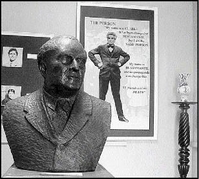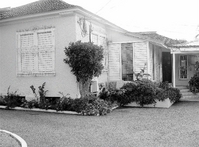Busta's house ... built while in detention
Published: Sunday | December 6, 2009


Photos by Mel Cooke
LEFT: A bust of Bustamante greets all in the museum's first room on the tour.
RIGHT: An exterior view of the Bustamante Museum.<
Mel Cooke, Gleaner Writer
IN THE age of instant world-wide communication and virtual tours, it is easy to choose and purchase a house without actually setting foot over the threshold until after the sale is complete, and be perfectly satisfied.
In 1940, with technological developments largely geared towards settling European-centred disputes in what became known as World War II, the man who would lead Jamaica into independence 22 years later ordered his home built without being able to observe the construction process.
Alexander Bustamante was in detention at Up Park Camp, St Andrew, when he instructed his lawyers to have the house built at 24 Tucker Avenue, St Andrew, a brisk walk away from where he was incarcerated. He had bought the half-acre property a year earlier.
He lived there for 20 years after being released in 1942, moving to Jamaica House, the official prime minister's residence, as the country became independent. However, the home is now the Bustamante Museum, which is appropriate, as project manager for the museum, Nora Strudwick, explains.
Strudwick says that even when they lived at Jamaica House, and then in the Blue Mountains at Irish Town, 'Busta' and 'Lady B' kept 24 Tucker Avenue as a personal residence.
The property was transferred to the National Heritage Trust in November 1990 and declared a national monument five months later, but there had been an intention to make it a lasting monument to Bustamante years earlier.
Collar
Strudwick shows The Sunday Gleaner a letter dated August 13, 1979, in reply to Lady Busta-mante's request, giving permission for a collar which came with his knighthood to be retained, as it was to be part of a museum project for the National Hero.
So the Bustamante Museum is open three days a week - Mondays, Wednesdays and Fridays - from 10 a.m. to 2 p.m., to individuals and small groups. Strudwick points out that it falls under the Bustamante Foundation, chaired by Dr Victor Page with Seragh Lakasingh instrumental to its development. The CHASE Fund has also provided substantial support.
Strudwick says that there are many more artefacts to be put on display in the air-conditioned Bustamante Museum, and there are plans to increase the space available. The house has been kept in its original condition, including the wallpaper at points. Even the windows which have been closed off to create more space for display can be easily returned to their original state, as a temporary solution has been used.
Although a few adjustments have been made on the inside to accommodate the displays, Strudwick says "nothing has been changed on the outside".
"The project is still developing," Strudwick told The Sunday Gleaner.
Lady B's chair on the left and Busta's on the right, with her musical instruments ready to hand.
Bustamante still speaks through his words
SIR ALEXANDER Bustamante was a noted orator, adept at whipping a crowd into a fervour and also delivering a memorable quip to tickle the funny bone.
While the Bustamante Museum does not, with its limited space at present, have a section focusing on his words, naturally, some of what 'Busta' said has made its way into 24 Tucker Avenue.
In the first room, his awareness of and comfort with issues of race is exemplified with, "I am a happy medium between white, black and coloured. I belong to all." He did not, however, wear the name 'Clarke' well, so a notice from the Daily Gleaner of September 30, 1944, advises " ... that on the fifteenth day of September, One Thousand, Nine Hundred and Forty-Four, I formally and absolutely renounced, relinquished and abandoned the use of my said surname of 'CLARKE' and then assumed and adopted and determined thenceforth and on all occasions whatsoever to use and subscribe the name of William Alexander Bustamante instead of the said name William Alexander Clarke".
A few letters from Bustamante to Gladys Longbridge while he was in detention show his affection of and admiration for her. His original writing is beside typewritten versions. On Wednesday, January 8, 1940, he wrote:
"You have been so brave - so dutiful - so faithful - so very true - so sincere and kind - any and everything you have done, whatever way it turned, good or bad - it was always meant for the best - for me you are faultless. I can see that you are already dying - don't fret too much over me - keep your chin up."
Pride and courage
In his independence speech he said, "I speak with humility, fully conscious of the opportunities of service that are mine. But I speak also with pride and courage because I have faith in my people and I know you will all respond to the challenge of this new era ..."
On his personal coat of arms, a part of his knighthood, Bustamante had asked for the inscription 'I say what I mean and I mean what I say'. The closest that the Latin translator could come was Mers flecti nescia - a mind that cannot bend.
Interestingly, although he was given several cigar cases, Strudwick says Bustamante did not smoke.
-M. C.


















